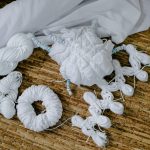If slime lands on your upholstery, start by gently scraping off excess with a spoon, then blot the spot without rubbing. Spray a vinegar-water mix to soften the slime, wait a few minutes, and dab with a clean cloth. For stubborn residues, rubbing alcohol or a baking soda paste works wonders. Always test cleaners on a hidden spot first. Taking these steps quickly saves fabric. Keep going to uncover more tips for tough stains and prevention strategies.
Table of Contents
Key Takeaways
- Quickly remove excess slime with a spoon and use ice to harden slime for easier scraping without rubbing.
- Identify slime type and upholstery fabric to choose the safest cleaning method.
- Spray a vinegar-water solution on the stain to soften slime, then blot and lift with a clean cloth.
- Use rubbing alcohol or baking soda paste for tough slime spots before gently cleaning with mild soapy water.
- Protect furniture by designating slime play areas, using washable covers, and cleaning spills immediately.
Identifying the Type of Slime and Upholstery Material
Before you begin removing slime from your upholstery, you’ll need to identify both the type of slime and the fabric you’re dealing with.
Slime can range from store-bought, often made with glue and borax, to homemade varieties that might include ingredients like shampoo or detergent. Knowing the slime’s composition helps you choose the right cleaning approach.
Understanding whether slime is store-bought or homemade guides you to the most effective cleaning method.
Next, check your upholstery fabric—whether it’s cotton, microfiber, leather, or synthetic. Each material reacts differently to cleaning solutions. For instance, leather needs gentler treatment, while synthetic fabrics can usually handle stronger cleaners.
You can usually find the fabric type on your furniture’s care tag. Taking the time to identify both slime and fabric guarantees you avoid damage and increase your chances of a successful cleanup.
Immediate Steps to Remove Fresh Slime Stains
Once you know the type of slime and fabric you’re dealing with, you can act quickly to prevent the stain from setting.
First, carefully lift off as much slime as possible using a spoon or dull knife—avoid rubbing, which pushes slime deeper.
Next, blot the area gently with a clean cloth to absorb excess moisture. Avoid scrubbing, which can damage upholstery fibers.
If the slime is still sticky, place a few ice cubes in a plastic bag and press it against the stain to harden the slime, making it easier to scrape off.
Throughout this process, work from the edges toward the center to contain the stain. Acting fast with these steps greatly increases your chances of a successful cleanup.
Using Household Ingredients to Break Down Slime
Although slime can be stubborn, you can often break it down using common household ingredients.
Start by mixing equal parts white vinegar and water in a spray bottle. Lightly spray the stained area, then let it sit for five minutes to soften the slime.
Next, gently blot the spot with a clean cloth to lift the slime without spreading it.
Another effective option is a small amount of rubbing alcohol applied to a cloth—dab it onto the stain to dissolve slime’s sticky texture.
Baking soda also helps; sprinkle it over the area, then add a few drops of water to create a paste. Let it sit for 10 minutes before brushing it off.
These simple ingredients break slime down, making cleanup easier without harsh chemicals.
Deep Cleaning Techniques for Persistent Slime Residue
If household ingredients don’t fully remove the slime, you’ll need to try deeper cleaning methods to tackle stubborn residue.
Start by vacuuming the area to lift loose particles. Then, mix a solution of warm water and a few drops of mild dish soap. Use a clean cloth to gently blot the stain, avoiding rubbing, which can push slime deeper into the fibers.
Vacuum first, then gently blot slime stains with warm, soapy water—avoid rubbing to prevent embedding.
For tougher spots, apply a small amount of upholstery cleaner following the product instructions. You can also use a soft-bristled brush to agitate the area lightly.
After cleaning, rinse with a cloth dampened with plain water to remove any soap. Finally, blot dry with a towel and let the upholstery air dry completely before using it again to prevent mold growth.
Preventative Measures to Protect Your Upholstery From Future Slime Spills
Since slime can be tricky to remove completely, taking steps to protect your upholstery beforehand will save you time and effort.
Start by designating a specific play area with easy-to-clean surfaces like tile or hardwood. Use washable slipcovers or throws on your furniture—they act as barriers and are simple to toss in the laundry if slime gets on them.
Encourage kids to wash their hands before touching upholstery and keep slime confined to a table or mat. Store slime in sealed containers to prevent accidental spills.
Regularly inspect your furniture for any slime traces and clean them promptly. These proactive measures will reduce the chances of slime stains, helping you maintain your upholstery’s appearance and avoid tough cleanups down the road.
Frequently Asked Questions
Can Slime Stains Cause Allergies or Skin Irritation?
Oh sure, slime might just be your new allergen best friend, ready to irritate your skin like a clingy ex. If you’re sensitive, it can cause redness or itching, so don’t let it linger on your upholstery!
Is It Safe to Use Commercial Slime Removers on Upholstery?
You can use commercial slime removers on upholstery, but you should test them on a small, hidden spot first. Make sure the remover’s ingredients are safe for your fabric to avoid damage or discoloration.
How Long Should I Wait Before Cleaning Dried Slime?
Like waiting for paint to dry before the grand reveal, you should let dried slime sit about 30 minutes. This helps it harden, making it easier for you to scrape off without spreading the mess further.
Can Pet Hair Affect Slime Removal From Upholstery?
Yes, pet hair can make slime removal trickier by sticking to the slime and upholstery. You should first remove as much hair as possible using a vacuum or lint roller before tackling the slime for easier cleaning.
Are There Professional Cleaning Services Specializing in Slime Removal?
Slime specialists skillfully scrub stubborn spots! Yes, you can count on professional cleaning services that specialize in slime removal from upholstery. They use expert techniques and tools, saving you stress and restoring your furniture’s fresh, flawless feel.
- Does Chiffon Fabric Stink - July 15, 2025
- Does Chiffon Fabric Affect the Economy - July 15, 2025
- Does Cotton Fabric Have a Nap - July 15, 2025







